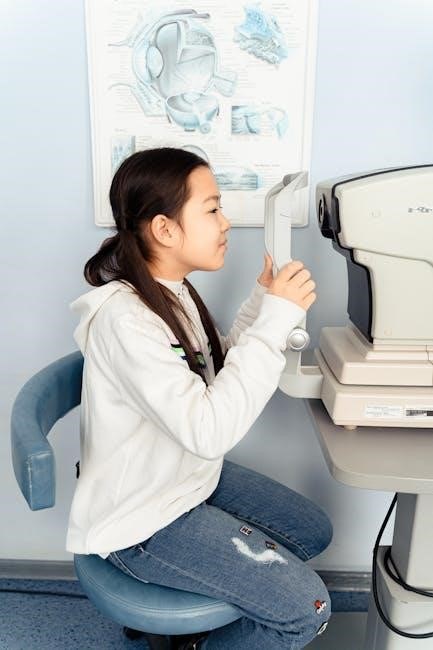The pediatric physical examination pdf provides a comprehensive guide to assessing children’s health, using a step-by-step approach to evaluate their development and identify potential issues, with over 300 photos and line drawings for reference always.
Importance of Accurate Examination
The importance of accurate examination in pediatric physical examination pdf cannot be overstated, as it enables healthcare professionals to identify potential health issues early on and provide appropriate interventions. A comprehensive and accurate examination is crucial in assessing the overall health and development of children, from birth through adolescence. By using a pediatric physical examination pdf, healthcare professionals can ensure that they are conducting thorough and accurate examinations, which is essential for providing high-quality patient care. The use of a standardized approach to examination, as outlined in the pediatric physical examination pdf, helps to ensure consistency and accuracy in assessments, which is critical in pediatric care. Additionally, accurate examination helps to build trust between healthcare professionals and patients, which is essential for effective care and treatment. Overall, the importance of accurate examination in pediatric care cannot be overstated, and healthcare professionals must prioritize this aspect of care.

Pediatric Physical Examination Handbook
The handbook is a portable guide for nurse practitioners and primary care providers to assess children’s health using a pediatric physical examination pdf always.
Key Features of the Handbook
The pediatric physical examination pdf handbook features a unique range of skills for assessing children’s health, including a spiral-bound design for quick reference in clinical settings. The handbook is known for its accuracy, consistency, and portability, making it an essential resource for nurse practitioners and primary care providers. With a focus on fetal development and key developmental stages of childhood, the handbook provides a comprehensive guide to physical examination. The inclusion of new sections on Telehealth and over 300 photos and line drawings facilitate learning and familiarize users with the examination process. The handbook’s key features also include a step-by-step approach to physical examination, preparing users to expertly examine children from birth through adolescence. Overall, the handbook is a valuable resource for healthcare professionals, providing the necessary skills and knowledge to assess and care for pediatric clients. The handbook’s features are designed to improve user experience and facilitate learning.

Conducting Physical Examinations on Pediatric Clients
Healthcare professionals use a structured approach to conduct physical examinations on pediatric clients, assessing their development and health, using various techniques always.
Techniques for Infants and Young Children
The pediatric physical examination pdf outlines specific techniques for assessing infants and young children, including observation, palpation, and auscultation methods. Healthcare professionals use a gentle and calm approach to put the child at ease, making the examination process more effective. The use of toys, games, and other distraction methods can help to reduce anxiety and stress in young children. The examination techniques are tailored to the child’s age and developmental stage, taking into account their unique needs and characteristics. For example, infants require a more gentle and subtle approach, while older children may require more direct and interactive methods; By using these specialized techniques, healthcare professionals can gather accurate and comprehensive information about the child’s health and development, enabling them to provide effective care and support. The pediatric physical examination pdf provides a comprehensive guide to these techniques, ensuring that healthcare professionals are equipped to provide high-quality care.

Quiet-to-Active Approach to Examination
The approach involves listening and observing before touching, making it a gentle and effective method for pediatric exams, using a systematic process always.
Benefits of this Approach
The quiet-to-active approach to examination has several benefits, including increased patient comfort and cooperation, which is especially important for young children and infants. This approach also allows for a more accurate assessment of the patient’s condition, as it reduces the likelihood of missing important signs or symptoms; Additionally, the quiet-to-active approach helps to establish trust between the patient and the healthcare provider, which is essential for building a positive and productive relationship. By using this approach, healthcare providers can gather more accurate and reliable information, which can inform diagnosis and treatment decisions. Overall, the benefits of the quiet-to-active approach make it an essential component of pediatric physical examinations, and it is widely used by healthcare providers in a variety of settings, including hospitals, clinics, and private practices, with great success and positive outcomes always.

Resources for Pediatric Physical Examination
Online resources, including pdf guides and websites, offer valuable information and support for healthcare providers conducting pediatric physical examinations always.
University of Tennessee Health Science Center
The University of Tennessee Health Science Center is a renowned institution that provides comprehensive education and training in the field of pediatric physical examination. With a rich history dating back to 1911, the university has established itself as a leader in healthcare education and research. The university’s colleges, including the College of Medicine and College of Nursing, offer a range of programs and courses that focus on pediatric physical examination and assessment. The university’s website also provides access to a range of resources, including pediatric physical examination pdf guides and online tutorials, which can be used by healthcare providers to improve their skills and knowledge in this area. These resources are designed to support the development of healthcare professionals and to promote best practices in pediatric physical examination. By utilizing these resources, healthcare providers can enhance their ability to assess and care for children.
Additional Resources and Training
Online courses and webinars offer pediatric physical examination pdf training and resources for healthcare professionals always available.
Alabama Public Health Training Network
The Alabama Public Health Training Network provides online courses and resources for healthcare professionals, including pediatric physical examination pdf training, to improve their skills and knowledge in assessing children’s health. The network offers a range of training programs, from basic to advanced levels, to cater to the needs of different healthcare professionals. With a focus on public health, the network aims to promote healthy lifestyles and prevent diseases among children. The network’s website features a user-friendly interface, allowing users to easily navigate and access various resources, including pediatric physical examination pdf guides, videos, and webinars. By utilizing the network’s resources, healthcare professionals can enhance their abilities to conduct thorough physical examinations and provide quality care to pediatric patients, ultimately contributing to better health outcomes for children in Alabama and beyond, with improved skills and knowledge always available online.
